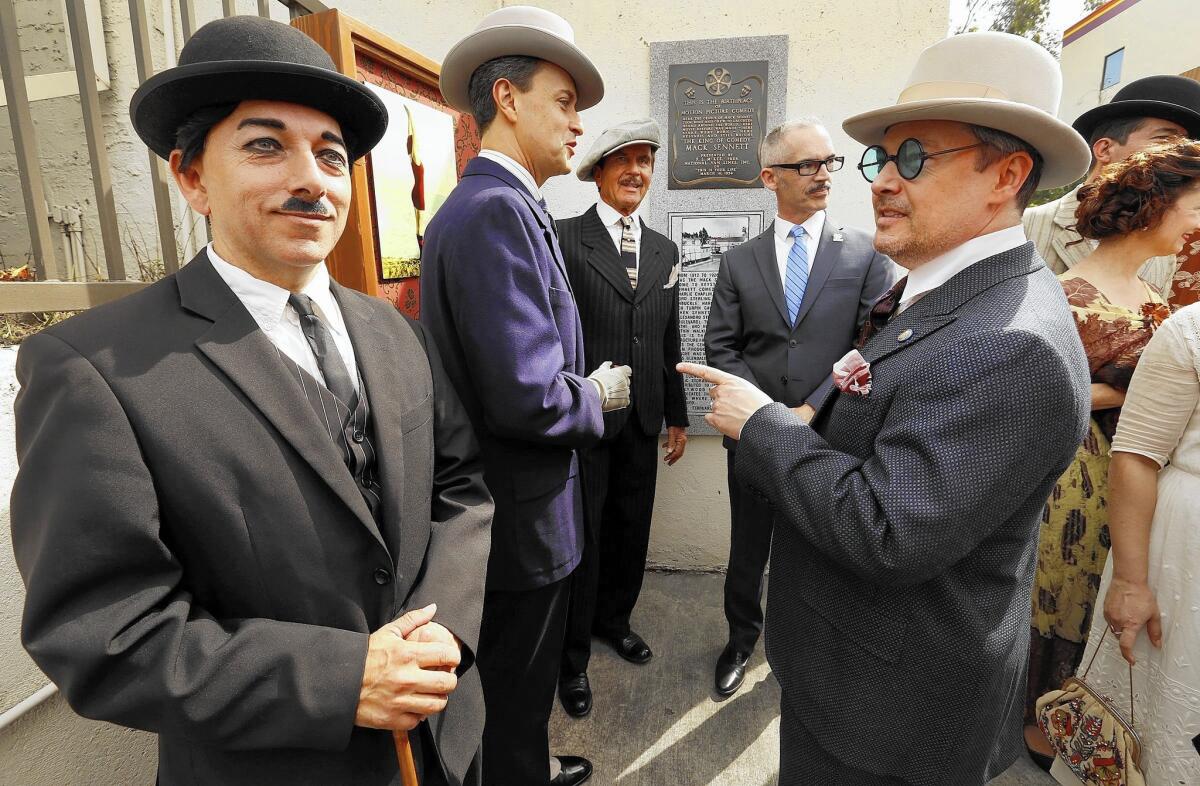Relocated marker in Echo Park salutes Mack Sennett’s first film studio

Searching out key locations in Los Angeles’ history often requires a vivid imagination. You have to squint to try to mute the modern-day reality, to conjure buildings that once stood but now are gone.
So it helped a bit that some of those who came out Thursday to celebrate one of the city’s first movie studios went to great lengths to set the scene — that women in woolen bathing suits twirled parasols, that a Charlie Chaplin showed up.
They had come to 1712 Glendale Blvd. in Echo Park to unveil a plaque on the site of Mack Sennett’s first studio — the place where, starting in 1912, the prolific producer and director once known as the King of Comedy created the bumbling Keystone Cops, popularized the pie in the face, made stars of Fatty Arbuckle and Mabel Normand, and first put Chaplin on film.
But there wasn’t much to see where they had gathered, in the parking lot of a self-storage facility, near a plain-looking concrete building that is the studio’s only surviving structure.
So one by one, speakers tried to pull the small crowd of film buffs and preservationists back to when the street they were on was called Allesandro, when the neighborhood was called Edendale, and when Edendale — not Hollywood — was the center of a burgeoning film industry, the place where the first filmmakers set up shop when they moved from the East to the West Coast.
On his way from City Hall to the site, said City Councilman Mitch O’Farrell, “I was imagining myself either riding a Red Car here … or driving a Model T.”
Stan Taffel, an actor and film historian, described how Sennett, who produced around 1,200 films, had used the surrounding neighborhood as his backdrop, exposing it to people everywhere.
“One hundred years ago, long before Hollywood would eventually become world famous as the entertainment capital of the world, this street, this neighborhood, the homes, the park with its own lake, this community, was the most recognized and well-known town in the world,” Taffel said.
Putting a marker on the site of the studio has been a project long in the making, led in recent years by O’Farrell’s office and a nonprofit organization, Hollywood Heritage, which seeks to preserve Hollywood’s past.
But it really dates to March 10, 1954, when Sennett appeared on the TV show “This is Your Life.”
At the time, National Van Lines had just bought the old studio property and presented him with a plaque to be placed on the property stating, “This is the birthplace of motion picture comedy.”
The plaque went up that same year, but somehow in the wrong spot — on the site of the Selig Polyscope Studio a few blocks away. There it stood for years, riling those who knew better, until in 2007, Robert Birchard, a film editor, film historian and past president of Hollywood Heritage, persuaded a developer who had just bought the land it was on to let Hollywood Heritage take it.
That it had survived so long was a miracle, he said.
“The plaque looked like it was solidly anchored in a concrete obelisk, but in fact it was made of 2-by-2s, chicken wire and a brown coat of plaster,” Birchard said. “Anybody could have come along at any time and popped it off.”
As luck would have it, just before he went to pick it up, someone covered it in spray paint, which had to be painstakingly removed.
The new marker includes not just the original plaque but an added inscription, recounting the history both of the studio and of the plaque’s misplacement. Hollywood Heritage raised the money, partly through an online campaign.
After the unveiling Thursday, Public Storage invited the visitors to tour the last-standing studio building, a Los Angeles Historic-Cultural Monument that in Sennett’s day was a “dark stage,” used for indoor filming of interior scenes, under electric lights.
They took the elevator to what is now the third floor, where they came out onto a long row of numbered, metal-gated storage units. But then they looked up and saw the original wooden ceiling, complete with pulleys and hardware from the days of silent film.
Sometimes the history is there. You just have to know where to find it.
Follow City Beat @latimescitybeat on Twitter and at Los Angeles Times City Beat on Facebook.
More to Read
Sign up for Essential California
The most important California stories and recommendations in your inbox every morning.
You may occasionally receive promotional content from the Los Angeles Times.











